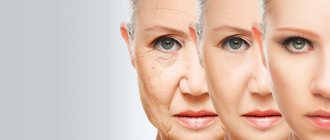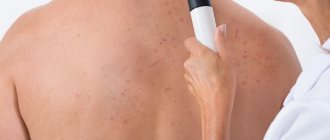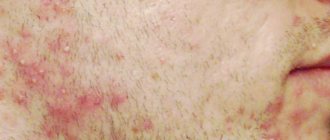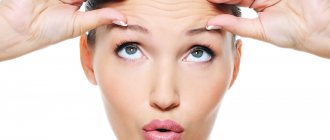Hormones affect many functions of our body, and disruptions to the endocrine system affect our health, well-being, figure and skin. Estrogen, progesterone, testosterone, insulin and thyroid hormones significantly affect the condition of the skin. Dr Terry Loong, director of London's Skin Energy clinic, explains how hormonal imbalances in women affect their skin and what methods exist to restore hormone balance.
Sex hormones: high testosterone and low estrogen
The most popular disease, acne, is undoubtedly associated with rapid hormonal changes. High levels of testosterone are responsible for juvenile acne, which affects up to 70% of teenagers.
In this case, men have it a little easier - their sex hormones usually stabilize and remain stable for many years. Women are more likely to develop adult acne due to fluctuations associated with menopause and pregnancy. The sebaceous glands are very sensitive to the action of androgens - that is, the aforementioned testosterone and its derivatives, and when the level of these hormones in the blood increases, more sebum is produced.
On the other hand, sex hormones - estrogens, which predominate in the body in women, provide better skin hydration, maintain its elasticity and accelerate wound healing. Hence the rapid deterioration in skin quality in menopausal women, when estrogen levels decrease.
Hair fragility and loss
How do hormones affect the skin?
ESTROGEN:
- Stimulates cell growth and turnover.
- Reduces the size and activity of the sebaceous glands.
- Makes sebaceous secretions less viscous.
- Increases fat reserves.
- Retains fluid in the body.
- Disturbs blood sugar levels.
- Leads to a decrease in zinc.
- Reduces the supply of oxygen to cells.
- Stimulates the production of hyaluronic acid.
- Leaves skin texture softer and calmer.
The effect of estrogen on women's skin is obvious. The regulating effect on the sebaceous glands means that a woman’s skin will be much less oily than a man’s. Estrogen also stimulates the production of hyaluronic acid, which not only keeps the skin soft and smooth, but also achieves optimal moisture levels. Estrogen production changes over the course of life. At the same time, our skin also changes.
ANDROGENS:
- Increases the number of cells in the basal layer.
- Increases the activity of the sebaceous glands.
- Increases the viscosity of sebum.
- Stimulates collagen production.
- Increases hair growth.
The behavior of the sebaceous glands is regulated by hormones. Men have higher levels of androgenic hormones than women - this can be seen if you compare the skin of different sexes. Because androgens increase the viscosity of sebum, men's skin is oilier and their pores are enlarged. Androgens stimulate fibroblast cells to produce collagen, resulting in thicker, firmer skin.
PROGESTERONES:
- They interfere with the functioning of estrogen receptors.
- Provide cells with oxygen, thus strengthening the skin.
- Stabilizes sugar levels.
- Normalize the content of zinc and copper.
Taking into account all the effects described above, let's take a look at the different conditions of our skin according to the periods of hormonal changes.
Hypothyroidism and hyperthyroidism - triiodothyronine, thyroxine and calcitonin
Other hormones that have a tremendous impact on the condition of the skin are triiodothyronine, thyroxine and calcitonin. A lack of these hormones leads to hypothyroidism.
Hypothyroidism usually manifests itself with symptoms such as:
- dry, scaly skin on knees and elbows;
- decreased tolerance to cold;
- fragility and hair loss.
An overactive thyroid gland, on the other hand, produces more hormones than needed. In this case, hyperthyroidism begins.
In turn, hyperthyroidism can manifest itself as:
- increased sweating;
- dermographism;
- redness of the skin of the face and neck.
What hormones affect your skin?
- Androgens
- Estrogens
- Progesterone
- Prolactin
- Oxytocin
- Melatonin
- Cortisol
- Dopamine
- Insulin
- Thyroid hormones
Testosterone and its derivatives are usually called male hormones - but in fact, everyone has both androgens and “female” estrogens, and only their quantity differs. Androgens stimulate connective tissue cells that produce collagen, resulting in renewal of the deep layers of the skin and maintaining its elasticity.
Lack of androgens, including age-related, reduces the protective function of the skin and the rate of its renewal - it gradually loses elasticity and density, becomes drier and thinner. An excess of androgens - for example, in the last phase of the menstrual cycle, a few days before menstruation - causes increased activity of the sebaceous glands, which makes the skin oily and prone to rashes.
The average female phenotype depends on estrogens - for example, the tendency to accumulate fat on the hips and other features of the figure. Estrogens are involved in the renewal of skin and hair cells. At the normal speed of this process, the skin remains elastic and hydrated - and contracts well after sudden weight changes.
With an excess of estrogen, problems with blood vessels may appear (for example, varicose veins or vascular networks in the legs), and body weight may also increase sharply.
Lack of estrogen in women can manifest as loss of strength, excessive and uncharacteristic hair growth, and decreased libido.
Progesterone
Every month, progesterone prepares the female body for pregnancy, and if pregnancy occurs, it helps to preserve and bear the child until the placenta takes over this function. The work of this hormone also affects the appearance: an increase in progesterone levels leads to fluid retention and swelling. In addition, the permeability of the vascular wall increases, and as a result the skin becomes more stretchable and prone to rashes, and the likelihood of pigmentation increases. An extra couple of kilograms shortly before menstruation is due to progesterone. Thanks to this hormone for all the favorite symptoms of PMS: irritability, short temper, touchiness, tearfulness and lethargy.
An increase in progesterone levels in the last phase of the menstrual cycle is normal. You can suspect that there is too much of it on other days if there is obvious stretchability of the skin, swelling, increased cellulite (this occurs due to fluid retention), mood swings, and hyperpigmentation. A lack of progesterone may be indicated by too long menstruation, brittle nails and hair.
This hormone is primarily responsible for the formation of breast milk and is actively synthesized during lactation - but its level can also increase in stressful situations and under emotional stress. Its excess provokes swelling, chest pain, and a tendency for the skin to become oily and rashes. A deficiency can lead to dry skin, headaches, and loss of strength. The only indirect benefit of prolactin for the skin is that it enhances the production of oxytocin.
This hormone is responsible for feelings of tenderness and affection, and in the largest quantities it is produced under the influence of prolactin after childbirth - this explains the instant wave of love for the newborn that occurs in some women. Oxytocin increases local (on the surface of the skin) immunity and reduces the risk of rashes. This hormone utilizes glucose, namely sugar - the main food of pathogenic bacteria, and the less it is, the lower the risk of inflammation.
Feeling good and looking fresh is hardly possible without normal sleep, and melatonin is responsible for its quality. Its synthesis occurs at night, from approximately midnight to four in the morning, during sleep and only in complete darkness. Night owls who are not sleeping at this time need to monitor their melatonin levels especially carefully.
Melatonin neutralizes the destructive effects of oxidative processes - it binds free radicals that are formed during the oxidation of, for example, fats. Oxidative stress is one of the main causes of visual aging of the skin (loss of shine and elasticity), so the condition of the skin directly depends on the level of melatonin. The level of melatonin is closely related to the level of another important hormone - cortisol, and it is the smooth change in their concentrations that brings us from sleep to wakefulness when daylight hours come. If you sleep in the light, there is more cortisol in the body and less melatonin.
Cortisol is commonly called the stress hormone, but it is involved in all metabolic processes - in case of stress, it is responsible for the instant mobilization of the body. If cortisol is in excess, it has a truly destructive effect on us. For example, carbohydrate metabolism and insulin production depend on its level, and its excess can lead to a typical redistribution of fat in the body. At the same time, the face, neck, and upper shoulder girdle become very plump, and the legs and pelvis lose weight disproportionately.
When cortisol levels increase, acne and flaking appear, the skin becomes oily and thin, and the risk of hyperpigmentation increases. Damage takes longer to heal and leaves behind scars and age spots. In addition, cortisol causes swelling, makes hair brittle, and can lead to seborrhea and even hair loss.
This hormone goes hand in hand with cortisol - it is called the “happy hormone.” During natural aging, dopamine levels decrease—and the problem, of course, is not aging itself, but the associated risks of disease and general malaise. Dopamine deficiency can be noticed by impoverished facial expressions, lethargy, stooping, stiffness of movements, loss of dexterity and plasticity.
Insulin, as you know, is responsible for the level of glucose in the blood, and the development of resistance to it is associated with one of the most dangerous diseases - diabetes mellitus. In already developed diabetes mellitus, the main fear is complications - both from the heart and large vessels, and from the capillaries that feed the skin. In severe cases, disruption of this process leads to necrosis of the tissues of the feet and can result in amputation.
Emerging problems with insulin levels can externally manifest themselves in the form of hyperpigmentation, decreased protective function of the skin, a tendency to inflammation, and darkening of certain areas - for example, in the armpits and on the neck.
Thyroid hormones
Thyroid hormones are involved in many processes - they regulate metabolism, vitamin A synthesis, and the rate of oxygen absorption. If the function of the thyroid gland is reduced, dryness, jaundice, and marbling of the skin appear. Hair falls out, nails break and peel, and hairs on the outer third of the eyebrows may also fall out. If thyroid hormones are in excess, hair becomes thin, limp and oily, and skin becomes oily, hot, and sweats excessively. Often this condition is accompanied by hyperpigmentation. Published by econet.ru.
PS And remember, just by changing your consciousness, we are changing the world together! © econet
Did you like the article? Write your opinion in the comments. Subscribe to our FB:
Cushing's syndrome
Primary adrenal hyperactivity, Cushing's syndrome, is caused by excess cortisol. The most common symptoms are:
- abdominal obesity;
- stretch marks;
- redness of the facial skin;
- acne;
- hirsutism;
- tendency to bruise;
- swelling;
- muscle atrophy (especially in the limbs).
Excess cortisol, resulting from an overactive anterior pituitary gland, causes similar symptoms.
Effects of insulin, thyroxine, dehydroepiandrosterone and somatotropin
It should be noted the influence of hormones on the skin of this group;
- Insulin is responsible for the concentration of sugar in the blood. When deficient, it causes diabetes mellitus, in which the skin becomes pale and excessively sticky.
- Thyroxine is involved in the growth of hair on the head. If a woman experiences their loss, as well as eyebrow loss, then this is a direct sign of thyroxine deficiency in the blood. The lack of this hormone indicates the presence of heaviness of the eyelids, blurring of the face, and dryness of the epidermis.
- Dehydroepiandrosterone is produced less frequently in older people. It is responsible for the firmness of the skin. It also produces antioxidants and participates in the healing process of skin wounds. A small amount of it leads to the appearance of skin pigments, wrinkles, sagging, and damage heals more slowly.
- Somatotropin is rightly called growth hormone. It is what helps give facial skin firmness and tone. If it is not produced enough, the skin folds in the chin and neck area begin to sag greatly, and vertical wrinkles appear on the cheeks. Somatotropin is produced during sleep.
Hirsutism
Hirsutism is the appearance of excessive body hair in women. Dark, strong hair grows on the chin, cheeks, neck, abdomen, lumbar region, and sometimes also on the lower limbs and feet.
Hirsutism
Hirsutism is a symptom of androgen excess. Less commonly, this indicates excessive sensitivity of the hair follicles to the action of androgens. The condition can also be caused by taking certain medications and stimulants.
Testosterone
Testosterone is a well-known male sex hormone that affects the skin in the most direct way. It is secreted by the testes in men and the ovaries in women, muscle mass directly depends on it, and the skin remains elastic and moisturized with a normal balance of the hormone in the body. It should be noted that a lack of testosterone almost does not harm the fair sex, but men can turn pale and even acquire cellulite. Loss of muscle mass, feminine features, subcutaneous fat and dry skin mean you need to take care of your testosterone levels. Protein diets and giving up bad habits, coupled with taking medications with magnesium and zinc, can help.
Diabetic dermatopathy
Diabetic dermopathy (called diabetic shin spots) are painless, non-pruritic, light brown maculopapular lesions. Over time, they disappear, leaving brownish discolorations and atrophic scars.
Skin problems as a symptom of diabetes include:
- dryness;
- itching;
- recurrent mycoses;
- delayed healing of even small wounds;
- may be the first symptom of diabetes.
Mycosis
Forms of negative effects of hormones on the epidermis
Common forms of negative hormone effects include:
- acne before menstruation;
- acne;
- menopause.
In the first case, the rash may appear due to weak estrogen production. Before the onset of menstruation, the female body experiences an increase in estrogen levels. Then its amount in the blood decreases, and is replaced by increased production of progesterone. This hormone is known to regulate estrogen production. At the same time, women experience all the signs of skin diseases that occur with an excess of androgens in the blood.
Not only teenagers, but also older women are susceptible to acne. Unlike premenstrual rash, acne can occur at any time. And this does not depend on the woman’s menstrual cycle. It is worth noting that acne occurs only from an excess of androgens in the blood, since the ovaries and adrenal glands in women produce only half of all androgenic hormones. The rest are produced by the epidermis itself, resulting in acne and pimples on the face. Acne can occur on both oily and dry skin. Predisposition to this disease is associated not only with hormones, but with heredity and race.
During menopause in women, which occurs after 40 years, there is a hormonal imbalance in the body. Estrogen is produced in smaller quantities, and testosterone begins to predominate in the blood. The consequence is roughening of the skin, the appearance of acne, and hair growth. The facial skin is poorly moisturized and wrinkles appear. For this reason, at this age it is necessary to take hormonal medications containing estrogen.
Acromegaly
Symptoms of acromegaly are thickening of the skin, enlargement of the details of the face, hands and feet, deep scarring of the scalp, widening of the tongue, an increase in the number of fibroids, foci of dark keratosis, thickening of the nail plates, excessive activity of the sweat and sebaceous glands.
As you can see, many skin and hair problems can be associated with hormonal imbalances. Therefore, you should not be surprised if a dermatologist refers a patient not for a cosmetic procedure, but for tests. Having found out the exact cause, he will prescribe drug therapy, after which it will be possible to begin treating the consequences of hormonal disorders - acne, pimples, scars, scars and other problems.
What are hormones
Hormones are biologically active substances that control the functions of the human body. There are more than a hundred of them. They are produced by many organs of the endocrine system - from the hypothalamus in the brain to the ovaries. These encrypted biochemical messages are designed to start or, conversely, stop certain processes.
Hormones enter the blood, which delivers them to the right place - to the target cells. Each hormone has its own cellular receptor. The hormone clings to it, and the cell receives a signal on how to behave further. There is no receptor or it is inactive - and the transmitted signal will not be received, no matter how many hormones are “sent on the task”.
When too many/too few hormones are produced or cells lose sensitivity to them (receptors do not work properly), problems begin. Including the skin.
At the age of 25, the skin of healthy people is characterized by an ideal balance of hormones. © iStock
DHEA – dehydroepiandrosterone
This hormone, produced in the adrenal glands, is called the hormone of youth. It regulates the sexual sphere, increases sexual desire, and is responsible for the menstrual cycle. Lack of DHEA affects the appearance, aging a person:
- dry, thin, dull skin;
- unclear oval face;
- a network of fine wrinkles on the face;
- flabby cheeks near the mouth;
- age spots on the skin.
Thus, hormones, their deficiency or excess, significantly affect the condition of our skin. With hormonal imbalance, no amount of the most expensive creams, lotions, or cosmetic procedures will give the desired effect. In these cases, it is necessary to first eliminate disturbances in the hormonal system, and only then contact cosmetologists. Only then will it be possible to achieve a positive result.
Thyroid hormones of the thyroid gland
These hormones, produced by the thyroid gland, are involved in the metabolism of fats, proteins, carbohydrates and help supply nutrition to the entire body. Their deficiency affects the skin as follows:
- the skin on the face turns pale and becomes too dry;
- the face becomes puffy and blurred;
- hair becomes thinner, thinner and duller.
Prolactin
This hormone is primarily responsible for the formation of breast milk and is actively synthesized during lactation - but its level can also increase in stressful situations and under emotional stress. Its excess provokes swelling, chest pain, and a tendency for the skin to become oily and rashes. A deficiency can lead to dry skin, headaches, and loss of strength. The only indirect benefit of prolactin for the skin is that it enhances the production of oxytocin.
Essentially, estrogens help our skin and hair stay young. Of course, with puberty, menstruation and menopause, progesterone is also a key player. However, research is still scarce in this area. Future research will hopefully shed some light on the interaction between estrogens and progesterone to better understand these reported changes in skin and hair.
Hormones under a magnifying glass
Coarser hair, thicker, oilier skin, and typically a later onset of signs of skin aging are all linked to testosterone. Female pattern baldness or pattern baldness is attributed to increased androgen levels and is the most common cause of hair loss in women. With age, the estrogen-androgen ratio becomes unbalanced, and changes are observed after menopause. Because androgens, and testosterone in particular, are involved in sebum production, women may experience increased oiliness or even adult acne when hormones become imbalanced during menstruation or menopause.
How skin changes during the menstrual cycle
The skin can be affected by a disruption in the production of estrogens, usually called female sex hormones: with their deficiency, the aging process accelerates, hair begins to grow more actively in hormone-dependent areas, and with an excess, pigmentation can increase. But the condition of the skin is also affected by fluctuations in hormone levels associated with the menstrual cycle.
The menstrual cycle is divided into two phases: follicular and luteal. In the first, follicular, phase, the follicle containing the egg gradually matures and begins to prepare for ovulation. During this phase, the level of estrogen is still low, and androgens, on the contrary, are at their peak. Under the influence of the latter, the skin becomes oilier and acne may worsen. But the ovarian follicles continue to grow and begin to produce estrogens - at this moment the synthesis of hyaluronic acid in the skin increases, which makes it moisturized and elastic. Finally, in the middle of the menstrual cycle, the pituitary gland begins to produce luteinizing hormone - the ovulation hormone. The follicle first becomes as round as possible, and then bursts, and the egg comes out of it. At this time, facial skin looks most radiant.
Immediately after ovulation, the second phase begins - the luteal phase, which continues until the start of the next menstruation. During this phase, a corpus luteum forms in the ovary, at the site of the burst follicle, which produces progesterone. This hormone promotes fluid retention, so that by the time your period begins, you may gain weight and your face may look puffy. At the same time, the epidermis becomes more loose, the skin, in order to protect itself, produces an increased amount of sebum, and acne may appear again. If fertilization does not occur, the corpus luteum becomes exhausted and dies, the level of progesterone decreases along with it, and the cycle begins again.
According to Inna Tsvetkova, a dermatologist and cosmetologist at the ROSH clinic, when planning procedures, you can take into account the phase of the cycle - for example, pain sensitivity is often increased in the luteal phase (5-7 days before the start of menstruation) and during menstruation. During this period, vessel fragility and bleeding increase, and the risk of bruising is higher. In the evening, the pain threshold and the skin's ability to recover are somewhat reduced. Of course, pain depends on your general condition, level of stress and fatigue. There are no uniform rules for everyone, but it is better to carry out interventions against the background of general well-being, and ideally also in the follicular phase of the cycle and during the daytime.
True, these rules do not apply if the patient uses hormonal contraceptives - in this case there is no menstrual cycle and hormone levels do not fluctuate, which means there will be no dependence of pain sensitivity on the phase of the cycle. Contraceptive drugs themselves often balance the condition of the skin and eliminate the manifestations of acne and hirsutism. But they should be prescribed by a gynecologist-endocrinologist who will take into account all aspects.
Menopause period
Menopause is an important period in the life of every woman, but it can also be difficult to bear. There are a number of structural and functional changes that occur in the skin as hormone levels decline with age, especially during menopause. As a consequence, these include dryness due to decreased sebum synthesis and lower water content in the skin. This dryness can lead to itching, flaking, and even eczema. The skin will also begin to lose its firmness as you age as fibroblasts and collagen levels decrease. It can also lead to a loss of skin density, which in turn leads to wrinkles and easy bruising.











